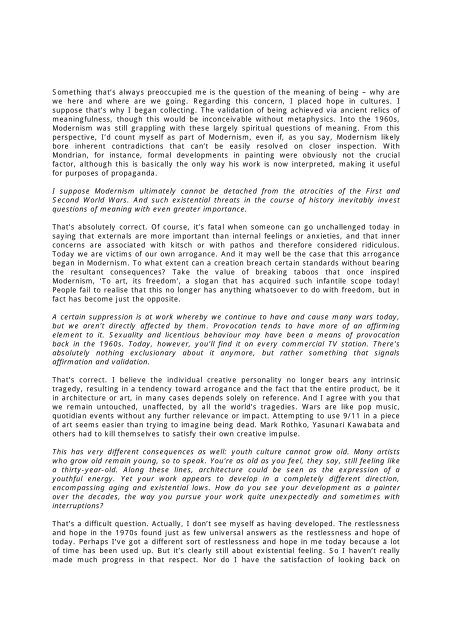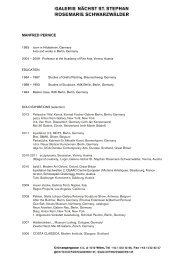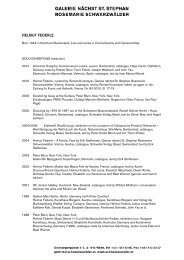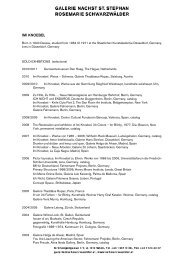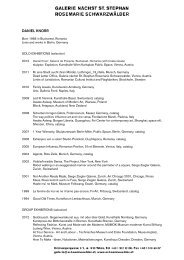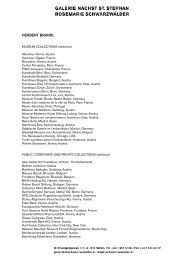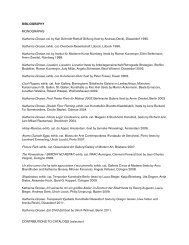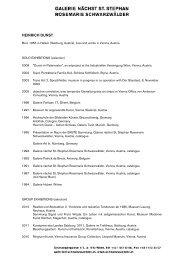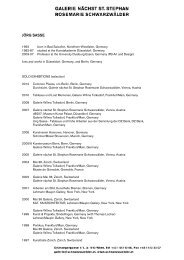Helmut Federle in conversation with Christian Kerez
Helmut Federle in conversation with Christian Kerez
Helmut Federle in conversation with Christian Kerez
Create successful ePaper yourself
Turn your PDF publications into a flip-book with our unique Google optimized e-Paper software.
Someth<strong>in</strong>g that’s always preoccupied me is the question of the mean<strong>in</strong>g of be<strong>in</strong>g – why are<br />
we here and where are we go<strong>in</strong>g. Regard<strong>in</strong>g this concern, I placed hope <strong>in</strong> cultures. I<br />
suppose that’s why I began collect<strong>in</strong>g. The validation of be<strong>in</strong>g achieved via ancient relics of<br />
mean<strong>in</strong>gfulness, though this would be <strong>in</strong>conceivable <strong>with</strong>out metaphysics. Into the 1960s,<br />
Modernism was still grappl<strong>in</strong>g <strong>with</strong> these largely spiritual questions of mean<strong>in</strong>g. From this<br />
perspective, I’d count myself as part of Modernism, even if, as you say, Modernism likely<br />
bore <strong>in</strong>herent contradictions that can’t be easily resolved on closer <strong>in</strong>spection. With<br />
Mondrian, for <strong>in</strong>stance, formal developments <strong>in</strong> pa<strong>in</strong>t<strong>in</strong>g were obviously not the crucial<br />
factor, although this is basically the only way his work is now <strong>in</strong>terpreted, mak<strong>in</strong>g it useful<br />
for purposes of propaganda.<br />
I suppose Modernism ultimately cannot be detached from the atrocities of the First and<br />
Second World Wars. And such existential threats <strong>in</strong> the course of history <strong>in</strong>evitably <strong>in</strong>vest<br />
questions of mean<strong>in</strong>g <strong>with</strong> even greater importance.<br />
That’s absolutely correct. Of course, it’s fatal when someone can go unchallenged today <strong>in</strong><br />
say<strong>in</strong>g that externals are more important than <strong>in</strong>ternal feel<strong>in</strong>gs or anxieties, and that <strong>in</strong>ner<br />
concerns are associated <strong>with</strong> kitsch or <strong>with</strong> pathos and therefore considered ridiculous.<br />
Today we are victims of our own arrogance. And it may well be the case that this arrogance<br />
began <strong>in</strong> Modernism. To what extent can a creation breach certa<strong>in</strong> standards <strong>with</strong>out bear<strong>in</strong>g<br />
the resultant consequences? Take the value of break<strong>in</strong>g taboos that once <strong>in</strong>spired<br />
Modernism, ‘To art, its freedom’, a slogan that has acquired such <strong>in</strong>fantile scope today!<br />
People fail to realise that this no longer has anyth<strong>in</strong>g whatsoever to do <strong>with</strong> freedom, but <strong>in</strong><br />
fact has become just the opposite.<br />
A certa<strong>in</strong> suppression is at work whereby we cont<strong>in</strong>ue to have and cause many wars today,<br />
but we aren’t directly affected by them. Provocation tends to have more of an affirm<strong>in</strong>g<br />
element to it. Sexuality and licentious behaviour may have been a means of provocation<br />
back <strong>in</strong> the 1960s. Today, however, you’ll f<strong>in</strong>d it on every commercial TV station. There’s<br />
absolutely noth<strong>in</strong>g exclusionary about it anymore, but rather someth<strong>in</strong>g that signals<br />
affirmation and validation.<br />
That’s correct. I believe the <strong>in</strong>dividual creative personality no longer bears any <strong>in</strong>tr<strong>in</strong>sic<br />
tragedy, result<strong>in</strong>g <strong>in</strong> a tendency toward arrogance and the fact that the entire product, be it<br />
<strong>in</strong> architecture or art, <strong>in</strong> many cases depends solely on reference. And I agree <strong>with</strong> you that<br />
we rema<strong>in</strong> untouched, unaffected, by all the world’s tragedies. Wars are like pop music,<br />
quotidian events <strong>with</strong>out any further relevance or impact. Attempt<strong>in</strong>g to use 9/11 <strong>in</strong> a piece<br />
of art seems easier than try<strong>in</strong>g to imag<strong>in</strong>e be<strong>in</strong>g dead. Mark Rothko, Yasunari Kawabata and<br />
others had to kill themselves to satisfy their own creative impulse.<br />
This has very different consequences as well: youth culture cannot grow old. Many artists<br />
who grow old rema<strong>in</strong> young, so to speak. You're as old as you feel, they say, still feel<strong>in</strong>g like<br />
a thirty-year-old. Along these l<strong>in</strong>es, architecture could be seen as the expression of a<br />
youthful energy. Yet your work appears to develop <strong>in</strong> a completely different direction,<br />
encompass<strong>in</strong>g ag<strong>in</strong>g and existential lows. How do you see your development as a pa<strong>in</strong>ter<br />
over the decades, the way you pursue your work quite unexpectedly and sometimes <strong>with</strong><br />
<strong>in</strong>terruptions?<br />
That’s a difficult question. Actually, I don’t see myself as hav<strong>in</strong>g developed. The restlessness<br />
and hope <strong>in</strong> the 1970s found just as few universal answers as the restlessness and hope of<br />
today. Perhaps I’ve got a different sort of restlessness and hope <strong>in</strong> me today because a lot<br />
of time has been used up. But it’s clearly still about existential feel<strong>in</strong>g. So I haven’t really<br />
made much progress <strong>in</strong> that respect. Nor do I have the satisfaction of look<strong>in</strong>g back on


